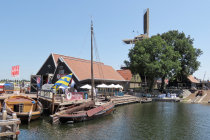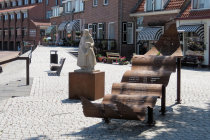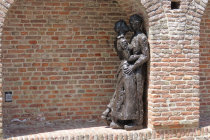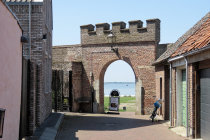the restored gate at the end of the Blauwverversteeg
the Vischpoort and remaining city wall seen from the inside. The lighthouse on top dates from 1851
the ROEK is a well maintained steam tugboat from 1930
this is the Botter Museum where they maintain old fishing boats of the botter type
the area behind the white drawbridge was where once the fish was auctioned
the veterans monument at the southern city wall
plastered-over frescos in the Grote Kerk were recovered in the 1970s
the monument for the many allied pilots that died here during WWII
in Hanseatic times standard weights came in the shape of horses
the Vischpoort dates back to the 14th century and is the only remaining waterside city gate
Harderwijk received city rights way back in 1231. Soon its merchant fleet traded goods along the North Sea' coast,
especially after joining the
Hanseatic League in 1265.
The
Koloniaal Werfdepot worked from Harderwijk
to recruit volunteers for the
Dutch East Indies Army. From 1814 till 1910 almost 150.000 men were recruited and shipped to Asia.
Many never made it back to Europe.
The closing of the Zuiderzee by the
Afsluitduik in 1932 dealt the deathblow
for the city's flourishing fishing industry.
Nowadays tourism shoulders the economy of Harderwijk, thanks to
the
Dolfinarium, a popular marine mammal park.
We visited Harderwijk on a hot and sunny day in July 2023.

















the old City Hall from 1728 dominates the market square




de Ouderwetse Bakkerij , a bakery, is located in a building from 1605









a monument commemorates the city's fishermen lost at sea









"the Kiss" from 2021 is supposed to become an icon of Harderwijk





















the Catharina Chapel is now a cultural center



it is hot so people flock to the beach at Strandeiland








































































